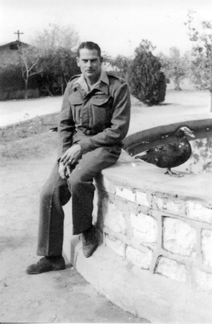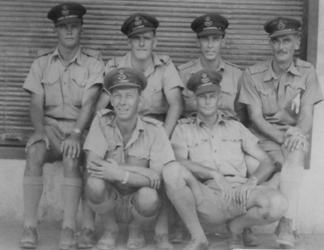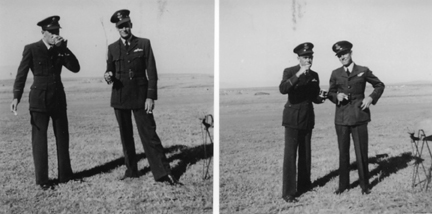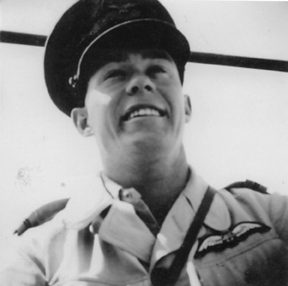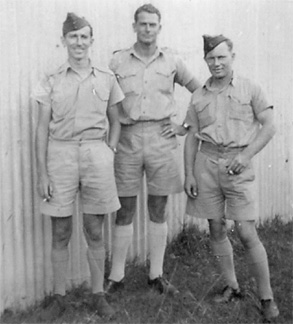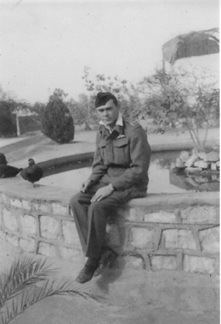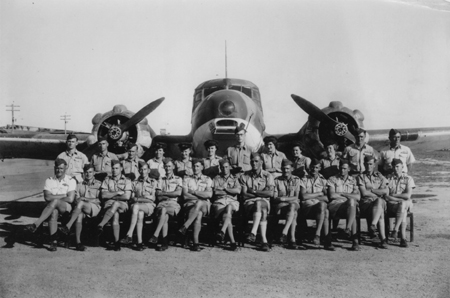 |
 |
|||||||||||||||
|
Flight Lieutenant William Reginald Cuttiford 404561 RAAF WR “Reg” Cuttiford was an RAAF P/O who hailed from Coogee, the pretty beachside suburb south of Bondi. He was born there on 7 June 1913. As a resourceful young man in the years of the Great Depression, Reg Cuttiford had a go at everything that came his way: a gift that would carry him through a richly varied war-time RAAF career.
Between 1930 and 1934, he tried his hand as a shearer, as a carpenter, a shop assistant, and as a car-driver before settling on a six year stint as a constable in the traffic police. Along the way he had moved to Queensland. Now with some confidence in his future, Cuttiford popped the question and he and Crena were married in 1938. Their son Geoffrey William was born in June 1941—by then, Reg had joined the RAAF and won his pilot’s wings.
In this official shot taken by a photo-bod from 23 Squadron at Archerfield, Cuttiford is third from the right in the centre row, marked by an arrow. Graham Mackay is seated third from the right in the front row, behind the dog. Third from the left, marked with an x, is another familiar but unidentified face. Cuttiford had enlisted in the RAAF at Brisbane in October 1940 at the age of 27, to be posted for initial training at 2 ITS Bradfield Park in North Sydney. Back in Queensland between December 1940 and May 1941 and selected as an officer cadet, Reg Cuttiford completed his flying training through 2 Elementary Flying Training School, RAAF Archerfield and 3 Service Flying Training School, RAAF Amberley. Having qualified as an RAAF pilot, his commission as Pilot Officer followed on 3 June 1941. Middle East training
Left to right [rear] Merv Powell (Brisbane) Jock McLean (West Aussie), Graham Mackay (Brisbane) Paddy Cartwright (England) [front] Gaffer Brown (England) Self [Cuttiford] having just bought the Town Hall or something. (WR Cuttiford) Probably at Middle East Pool about to depart for Kenya. By 19 August he was at RAF Station Mombasa, passing from there to Kenya Pool and finally to 70 OTU Nakuru (Kenya) in early October 1941. There, with RAAF crewmates Sgt JO (Owen) Penry (Observer) and 402201 Sgt AH (Alf) Kendrick, he was to undertake the Blenheim Operations Course required for posting to an operational Squadron. Passing out of 70 OTU, Cuttiford advanced to Flying Officer on 3 December 1941. Also at Nakuru were Graham Mackay (who had become a particular friend, from the number of shots in his photo collection), Neville Hargreaves Oddie (to be Mackay’s Observer), JH Joe Payne, and one Sgt George Kendrick.
Reg gave this 70 OTU shot full titling: place, date and names (left to right, back row then front row). Ging or Ginge (as opposed to Gaffer, RAF) is P/O RF Brown RAAF. A quirk of Australian history then made the nickname of 19th Century Queensland shearer of renown, one JR Jack or Jackie Howe, apt to apply to any other Australian man named Howe. Here F/O AM Howe 406249 RAAF is one such to be known as “Jack” Howe. Posted to 70 OTU for Blenheim operations training as a pilot, he then served with 55 Squadron in the Middle East before posting to 34 Squadron in India. Howe and his crew (F/O JD Hay RAAF and P/O T Lishman RAF) were shot down over the sea near Akyab in Burma in Blenheim IV V5925 on 10 November 1942. Reported missing, none survived.
In the left hand shot, the tall figure on the right is newly promoted F/O WR Cuttiford,next to him might be Graham Mackay—both are in RAAF blue. In the second shot, the un-named man in RAAF blue on the left might be the figure marked on the 2 EFTS shot. He appears in another aircraft shot of Reg’s. An early morning shot: they are brushing their teeth.
This un-named pilot is perhaps the RAAF man in blues of the second Gil Gil shot above. Reg only marked the place on the rear of the photo. Just possibly the same man as that marked x on the 2 EFTS shot.
No names in this shot and no flying badges on this state of dress, but the date and the grouping are significant. The central figure a P/O or F/O, is clearly Cuttiford himself. On the left, left hand in pocket, plainly a Sergeant. On the right, with cigarette in left hand, another airmen who on closer look is also a Sergeant. In other words, the make-up of a Blenheim crew. Checking another man’s photographs confirms the airman on the right to be Sgt Alf Kendrick (WOp/AG), which in turn suggests with virtual certainty that the man on the left is Sgt Penry (Observer). Crewed up at 70 OTU and perhaps towards the end of their Blenheim Ops Course. 211 Squadron and the Far East
Both these shots were titled Helwan by Reg, and the two seated shots of him (top) and of Mackay (left, above) were clearly taken on the same occasion. They had enlisted at 3 Recruit Centre Brisbane on the same day, 11 October 1940. Both had trained at 2 EFTS and both embarked for the Middle East on the same day. F/O Cuttiford, Sgt Penry (Observer) and Sgt AH Kendrick (WOp/AG) left Helwan on 25 January 1942 flying Blenheim IV Z7622. They were part of the first flight of six 211 Squadron aircraft, led by W/Cdr RN Bateson DFC with Sgt Dennis and Sgt WOp/AG Bill Baird in Z9649. Their journey, with a reconnaissance sortie thrown in, took 43hrs flying time over nine days, as Cuttiford recorded in his log book: Jan 25 Blenheim IV Z7622 Helwan to H4 Referring to the apparently erroneous “Llhobingwan”, Cuttiford and co had in fact arrived safely in Sumatra at little Lho’nga (now Lohknga). While the Dutch airline KNILM had included the nearby provincial capital Kota Radja (Koetaradja) on its East Indies maps from the late 1930s until 1941, few other maps of the time showed either that aerodrome some 6 miles South East of the town or the lesser used field at Lho’nga, some 6 miles to the South West. Notably, the crew of P/O B West RAAF flying in the fourth and final Flight led by S/Ldr Dundas also arrived safely: West’s WOp/AG Sgt JB Keeping recorded their destination as Kota Radja, of which he gave good report. The 2 February reconnaissance operation was not just Cuttiford’s first: it was 211 Squadron’s first in the Far East theatre. In Z9660, P/O EP Coughlan and crew Sgt PLD “Arch” Cummins, the Kiwi, and Sgt AP Richardson) also took part. They saw nothing. Next came his part in the [sic] 7 February “fighter escort” of the British convoy off Sumatra from P2 so pithily described by Bill Baird, which resulted in the loss of three Squadron aircraft and seven aircrew, as recorded by Burrage and reported by Penry. On 10 February 1942, it was Reg Cuttiford & co in Blenheim IV Z7622 who did the dash back to Pakenbaroe to scoop up P/O BL West (another Aussie), Sgt Riddle and Sgt Chignall who had been stranded after Z7643 first went u/s on take-off with S/Ldr Ken Dundas DFC at the controls. Repaired, with Bev West at the controls the aircraft was then damaged again attempting take-off on the partially repaired surface of the airfield. Finally, before strenuous efforts to make further repairs could be pulled off, Z7643 was strafed to destruction on the ground. Cuttiford also had a tough time on the damaged strip at Pakenbaroe, bending a wingtip on landing. As with the attempts to make Z7643 serviceable, Z7622 was repaired with bits off u/s aircraft to hand before returning to P2 on 11 February. On 13 February, Cuttiford and co took part in the sea-level sweep from P2 seeking the Japanese invasion force off Banka Is, returning 4:20hrs later to Palembang I in the dark and fright of a tropical storm. It was on this occasion that Mackay, Oddie and Payne were lost over the jungle, while P/O D Chalmers, 407273 P/O McInerney (Observer, RAAF) and 402202 Sgt GM Kendrick (WOp/AG, RAAF) ditched in the Java Sea. McInerney was never seen again, but by great good fortune, Kendrick and Chalmers were picked up by the yacht White Swan. Having returned to P2 on 14 February, on 15 February Cuttiford and his crew took part in the attack on the Japanese convoy approaching Banka Island, dropping 4x250lb and machine-gunning the vessels for good measure. Withdrawing to Batavia on 16 February 1942, still with Sgts Penry and 402201 AH Kendrick in Z7622, they joined the remnants of the air echelon at Kalidjati on 17 February. On 21 February, in Z9660 and just possibly attached to 84 Squadron, they flew on the last operation by 211 Squadron airmen, returning to Palembang to raid Japanese invasion shipping in the Moesi River, dropping 4x250lb GPs from 4,500ft. And safely home Penry had returned to Melbourne, disembarking at 1 Personnel Depot there on 28 March. It was 13 May 1942 before Kendrick returned, to 4 Embarkation Depot Adelaide, apparently from Ceylon. By 12 May 1942 Cuttiford had been posted to 1 SFTS, Point Cook. Promotion to Flight Lieutenant came on 1 April 1943, shortly after completing his Elementary Flying Instructors course. He spent the rest of the war in Australia, instructing at Elementary and Service Flying Training Schools around Australia: 1 SFTS Point Cook, 8 SFTS Bundaberg, CFS Tamworth, 8 EFTS Narrandera, and 11 EFTS Benalla all feature on his postings list, along with a stint at 71 Squadron RAAF at Coffs Harbour. Along the way he completed a wide variety of advanced courses, in instructing, in high altitude flying, and parachuting. By June 1945, with 1737:45hrs in his log, the Chief Instructor at 11 SFTS was rating him (as Group Commander) with that rare RAAF accolade: an above average flying instructor.
No title or date for this great formal shot. Cuttiford is third from the right in the front row. Clearly a staff shot: every one of the confident officers in the front row has his pilot’s wings. The aircraft is an Avro Anson, camouflaged above and trainer yellow below. Cuttiford rounded out his career at the Advanced Flying and Refresher Unit at Point Cook, where he passed the Advanced Flying Course in August 1945, passing on to No 39 School of Army Co-operation at Canberra. It was from this unit that he was released from the RAAF in October 1945, a highly qualified F/Lt. Living in Southport, Queensland, Reg Cuttiford took up civilian life again, working as an insurance inspector. Sadly, by 1951 he was a widower, his wife Crena having passed away. The heady RAAF days may have come vividly to mind: that year he applied for an active attachment to the Citizens Air Force Reserve, serving for a year before his health led to a medical discharge. When Mackay, Oddie and Payne’s aircraft was finally found in Sumatra in 1968, Reg carefully kept a cutting of the Courier Mail article and added it to his neat Log Book. Sources Cuttiford family correspondence and photographs via A Fryatt Jane’s All the World’s Aircraft 1941
www.211squadron.org © D Clark & others 1998—2025 |
|||||||||||||||
